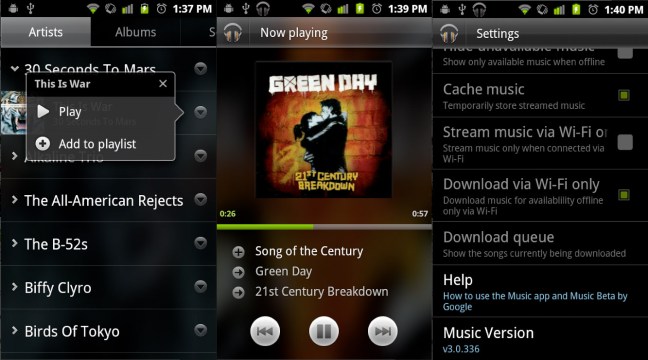
What seemed like a failed Android update for the folks at TechFrom10 has led to the discovery of new details about Google’s forthcoming cloud-based Android Music app.
“So on our Galaxy S Vibrant today we went to do a routine update of apps from the Android Market, only to discover that, for a completely unknown and frankly bizarre reason, our Android Market is now suddenly the test version we assume is loaded on Android developer’s devices,” writes Tim Schiesser at TechFrom10.
This inexplicable glitch gave Schiesser access to the developer’s version of the Android Market, which in turn allowed him to download a test version of Android Music 3.0.
The app is said to be similar to the Android Music app found on Android 3.0 Honeycomb (as well as the previously leaked version), but with additional, cloud-connected features. According to Schiesser, the new music app is “far better than the current music player in Android 2.3.”
Despite the praise, the app isn’t actually fully functional. In other words, there isn’t any music yet to stream due to the fact that Google is still negotiating the terms with the music industry to allow for streaming distribution.
From what we can determine from the test build, however, Android Music 3.0 will allow users to either download tracks or stream them directly from the Google cloud. The app also allows users to choose a WiFi-only mode, to keep from using up large amounts of precious data.
The update to Android Music appears to be a direct answer to the cloud-based streaming and storage service recently debuted by Amazon. Any music downloaded through Amazon is stored on the company’s cloud for free, and can be instantly streamed from either the web or through Amazon’s Android app. Music can also be uploaded to the cloud for streaming access, which costs customers about $1 per gigabyte for storage.
While Amazon’s service is groundbreaking, it still has a lot of bugs to fix before it can achieve any type of mainstream success. This means Google should have an easy time surpassing its one and only competition.
Apple is also rumored to have a cloud-based service in the works, though it is not yet clear whether it will include music-streaming capabilities, at least in for the near future.
Anyone interested in checking out Android Music 3.0 in its test stage, click here to download.
Editors' Recommendations
- I abandoned my iPad for an Android tablet and didn’t hate it
- Amazon Music now has a car mode, but don’t use it while driving
- The best radio apps for Android and iOS
- Apple iPhone SE (2020) vs. Google Pixel 3a: $400 phone showdown
- Why wait? You can download the Google Stadia Android app right now

